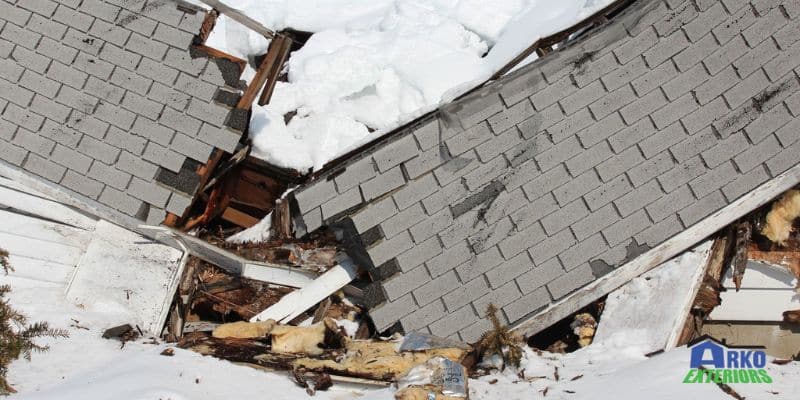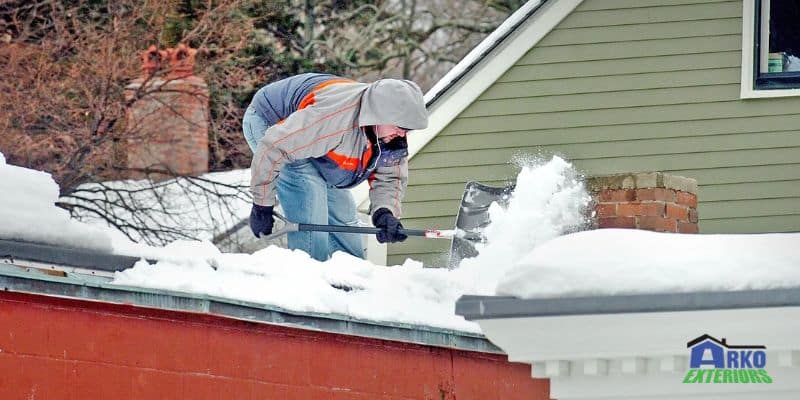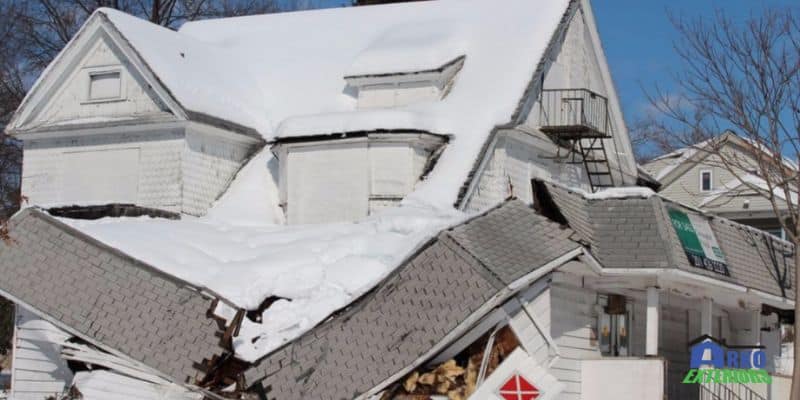Most houses have pitched roofs, but you could also find some houses with flat roofs. Flat roofs are a cheap and easy-to-maintain roofing style for modern-day houses. During the snow period, your flat roof may not be able to drain water effectively. Therefore, you must devise means of ensuring that it remains in top shape at all times.
What Is a Flat Roof?

A flat roof refers to a roof structure that comprises a minimal or zero slope to give almost a horizontally inclined surface. Unlike pitched roofs, flat-roofed buildings have a slope that is not more than 10 degrees and are usually level-looking. Many roofers nowadays use these products on modern commercial and residential houses.
There are many types of flat roof designs which include built-up roofs with multiple layers of bitumen and reinforcing fabrics. There are also single-ply membranes such as EPDM and TPO. Flat roofs provide a great deal of design flexibility at reasonable costs, but these considerations need to be well accounted for since this type does not allow natural water runoff.
It pays to do regular maintenance works on a flat roof, to avoid water pools that can result in damage or roof collapse in the long run.
Top Techniques to Safeguard Your Flat Roof Against Snow

Flat roofs are more prone to water infiltration during the wet winter and springtime seasons because they are incapable of handling the snow and ice it bears on them. Nevertheless, proper planning and routinely checking the roof will guarantee that your house does not succumb to the threat posed by the weather.
To avoid snow damage to your roof, here are some helpful tips:
1. Waterproofing your roof
Waterproofing your roof acts as an important armor against the damage inflicted by the snow. This ensures that you have some sort of barrier that does not allow the snow into your roof structure and consequently damage it. Allowed to penetrate, snow contributes to water leakage, structural damage, and even collapse.
Waterproofing is a process involving the application of specialized materials or coatings to render the surface of the roof impenetrable by water. This protective measure against moisture helps towards your roof’s winter resistance as well.
It functions as a precaution; reducing snow-related issues to secure your roof for a long time. Waterproofing your roof is a smart move towards securing your house against the negative impact of snow, assurance of tranquility as well and protection for your property.
2. Clear drainage outlets
It is essential to ensure that drainage outlets are cleared efficiently to protect against snow damage. The gutters and downspouts are important drainage outlets that help remove melted snow from the roof and foundation. Such outlets as debris and ice may accumulate water on the roof causing leaks and other problems in the structure.
Cleaning of these drainage pathways ensures that water flows freely; therefore, there will be no ice dams or excess weight on the roof.
Water that has accumulated due to ice dams formed by frozen meltwater at the edges of the roof damages the roof after a long time. Clearing the drainage outlets first helps in improving the snow damage defense strategy of a homeowner by eliminating the risks caused by water buildup as well as ice-related problems during the winter.
3. Inspect your roof annually
A thorough annual check-up of your roof is highly recommended. The roof is thoroughly checked for faults and weaknesses as part of the proactive process to strengthen the overall structure.
Early signs like cracks, leaks, or weakened areas are detected through professional inspections that enable quick fixes to problems before they worsen. The roof should be inspected annually too to determine if the previously conducted repairs were effective or not. Such a preventive approach ensures a long life for the roof and avoids unexpected and expensive problems.
However, homeowners may choose to conduct the visual inspection on their own. They may also hire a competent roofing professional for a thorough examination. Responsible roof maintenance involves regular annual inspections that provide a secure roofing system for the home.
4. Clear snow regularly
Clearing snow as often as possible can be considered a preemptive tactic. When snow accumulates on roofs, many problems occur, including extra weight stress, water penetration, and structural damage. This minimizes the chances of snow-related complications if you remove snow immediately.
The structural integrity of a building may be strained by excessive snow load which may result in to collapse of the roof. Furthermore, when snow melts, it may penetrate the roofing materials thus causing water damage, leaking, and weakening of insulation.
Snow clearing is especially important in areas that receive much snow. Besides protecting the structural stability of the roof, the preventive measures will go a long way in preserving other aspects of the building in general. Snow should be removed with suitable tools and techniques to prevent further damage to the roof surface.
5. Make sure your roof is properly insulated
Ensure that your roof is sufficiently insulated to prevent snow damage. Good insulation provides a shield against excessive heat movement from inside to outside your house. This insulation helps maintain uniform roof surface temperature in colder climates and prevents snow from melting irregularly.
Intermittent melting and refreezing of snow may take place on an uninsulated roof due to heat from inside. This process results in the formation of “icicle dams”. They are hazardous as they can prevent adequate drainage, creating ponds and leading to leakages or destruction of the structural design.
Invest in sufficient roof insulation. This helps in creating a thermal barrier that ensures even snow melts, thereby preventing ice dams and their accompanying damages during winter.
Conclusion
It is important to employ appropriate measures for protecting your flat roof from snow damage. These are effective defense techniques such as appropriate insulation and regular inspection. Ensuring long-term sustainability and durability for your flat roof over the winter period is all about early preparations and preventative actions.

